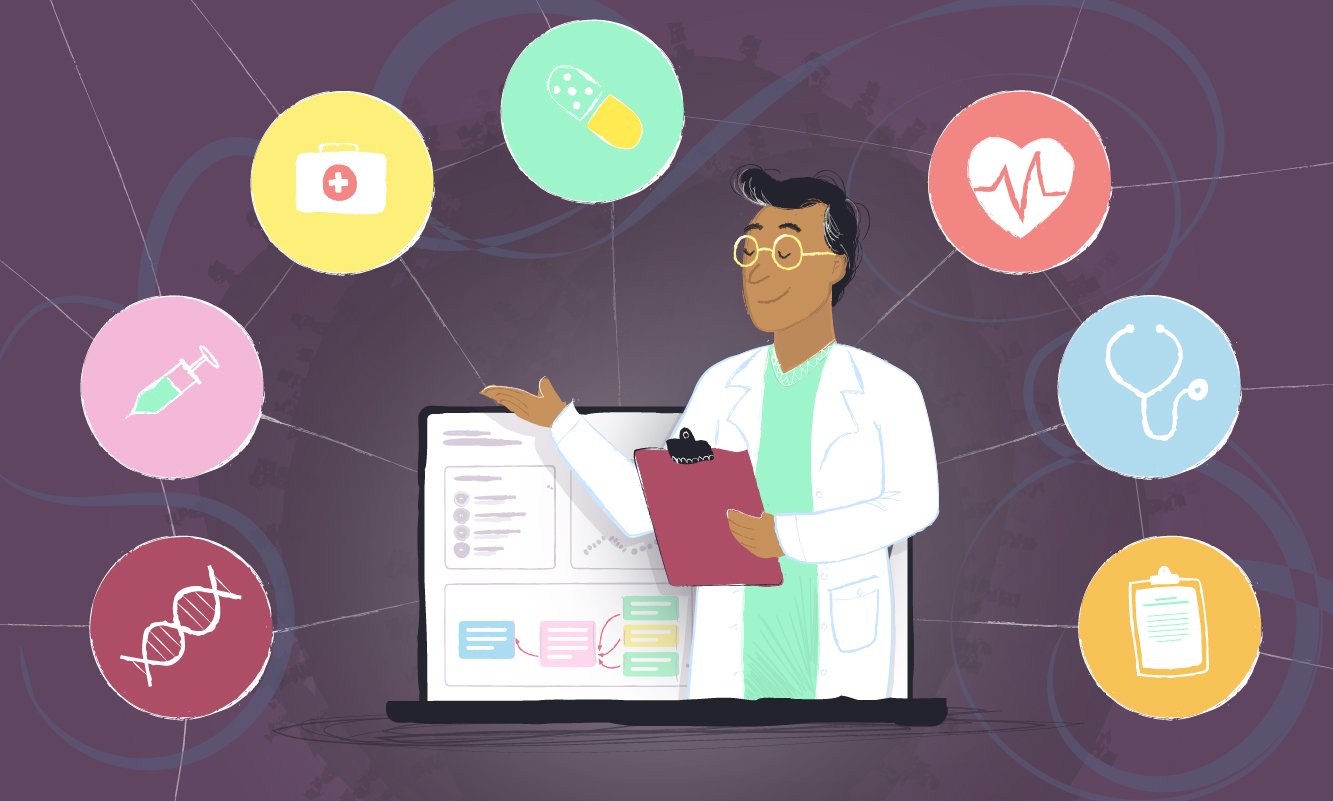Start improving with Life QI today
Full access to all Life QI features and a support team excited to help you. Quality improvement has never been easier.

Organisation already using Life QI?
Sign-up

Published on 23 February 2022 at 08:43

The NHS is creating Integrated Care Systems (ICSs) across England, which will enable place-based, joined up care across localities, as set out in the Long Term Plan. There are many challenges that these new ICSs and their leaders will face, not least tackling the backlog of planned appointments and clinics held up by the pandemic and the fact that populations are living longer and with multiple health conditions.
However, with the progress that took place during the pandemic in terms of how data and technology supports the delivery of care, the door has opened to innovation and ongoing improvement in digital health and with that, the promise of better patient outcomes. Data and technology can absolutely support ICSs to deliver enhanced care and should facilitate the way that they run.
As primary and secondary care, local government and social care will need to collaborate, so will technology systems need to ‘join up’ across localities, in order for patient care to be planned and delivered and so that providers, commissioners and local authorities can collaborate on care.
Partnership in ICSs will help bring in population health management improvements and reduce health inequalities. The three-tiered model of system, place and neighbourhood brings together the System - the region where a single ICS works; the Place – which is the district or town within an ICS – and will encourage place-based care and Neighbourhood – which are groups of GPs and community-based services.
This new structure demands real collaboration within ICSs - and this is where technology can really support transformation.
The pandemic has shown a meteoric rise in technology used to deliver care, improve patient outcomes and patient safety, and provide collaboration across localities. Faced with unanticipated challenges across the NHS, people had to – and did – use initiative and technology to continue to provide care when they were no longer able to see their patients. This is a perfect example of where technology can support ICSs, so let’s take look at how it can facilitate collaboration.
During the pandemic, barriers that could hold up innovation and discourage collaboration were temporarily lifted as people were allowed to work around them in order to deliver care in a different way. Technologies and systems - such as remote monitoring - flourished as people were no longer able to physically see their patients and digitally enabled care started to become the norm. Standards such as dm+d, FHIR and snomed - which promote interoperability across systems and ease of moving data across the system – gained more recognition.
The Long Term Plan devotes an entire chapter to technology: ‘Digitally-enabled care will go mainstream across the NHS.’ In this chapter, the authors talk about how technology can support ICSs in creating a joined up system to deliver healthcare and the benefits of partnerships where organisations can learn together and from each other.
As the NHS is looking to bring in standardisation in practice, process and seamless connectivity – they talk about how technology can help support this endeavour: ‘Whether it’s backend infrastructure allowing faster connectivity, end-user devices to enable remote working or state-of-the-art wearables or health tech to enable care providers in the ICS to access accurate, up-to-date patient data – technology will help to unify the service. Increased collaboration and communication will also allow organisations and services within the ICS to share knowledge and best practices, leading to standards improving across the system.’
Data sharing across local government, the NHS, public health and social care may seem like a daunting prospect, as the NHS is made up of ‘hundreds of separate but linked organisations, and the burden of managing complex interactions and data flows between trusts, systems and individuals too often falls on patients.’
However, the authors of the Long Term Plan go on to say that sharing data and interoperability of digital services has the potential to save time and resources and enable clinicians to focus on clinical care.’
For many years, there has been a will to share data more easily across the NHS – and there are languages, systems, solutions and integration methods that can make it easier to do this. However, these projects can be stalled and hit a wall due to obstacles. The pandemic made it easy to deliver care digitally, and now is the time for the health and care sector – and the newly formed ICSs - to build on this to create partnership in ICSs.
There is huge potential for digital to help the NHS face its challenges head on, and the NHSX delivery plan, published in December 2021 focuses on digital transformation in health and care. While standards such as FHIR (Fast Healthcare Interoperability Resources) - ‘a next generation messaging standards framework' and SNOMED CT ‘a comprehensive, multilingual clinical healthcare terminology,’ have been developed to help data sharing across health and social care.
The NHS Long Term plan has a section on the importance of technology in healthcare and advises that data should be interoperable and accessible by ‘mandating and rigorously enforcing technology standards (as described in The Future of Healthcare).’
The Department of Health and Social Care's paper 'Integration and Innovation: working together to improve health and social care for all' talks about the response to Covid-19 which has ‘shown us new ways to deliver care using innovative and creative solutions, exploiting the potential of digital and data, instead of needless bureaucracy.’
There’s already been some great work done across the NHS in terms of rolling out software solutions and in achieving ambitions which were set out in the Five Year Forward View and the Wachter report and it’s been demonstrated that digital and technology systems enable patients to access NHS information, while there are a growing number apps that have been assessed and approved via the NHS Apps Library.
So much is already happening in the world of digitally enabled care and digital transformation that can impact positively on the patient experience and outcomes, while strengthening partnership working between local government, the NHS, public health and social care.
‘Data is all around us in healthcare and we must continue to use it wisely to improve the outcomes for patients, which will enable digitally enabled care will go mainstream across the NHS.’ Timeliness and accessibility of data is vital. The Long Term Plan is relying on digital healthcare to help deliver its plan and anticipates the model of care to look very different in a decade’s time, when the NHS will be providing a ‘digital first’ provision, and clinicians will be supported by digital tools, with people being helped to manage their own health, guided by digital tools.
The Health Foundation's piece 'How better use of data can help address key challenges facing the NHS' explores how ‘the NHS in England can better use routine health data to help address current challenges, including winter pressures, the ongoing coronavirus response and the growing elective care backlog.’
While in the ‘Integrated Care Systems: design framework’, the authors look at data and digital standards, which will be centred around ‘What Good Looks Like framework’, which will support ICS leaders to move quickly with digital data transformation across their locality.
This is where systems such as Life QI come into play, as access to data improves decision making. Life QI is a leading improvement project management and analysis platform which enable you to run, organise and measure all your improvement work in one place. The solution supports NHS and other organisations to measure impact and supports change, by making Quality Improvement (QI) data easy to access which helps improve decision making.
Units such as NHSX and NHS Digital – soon to be merged - were created to drive the digital transformation of care and encourage timeliness and access to data. They will be relying heavily on the digitalisation of the NHS service, which will enable providers to identify those patients at risk from their online healthcare records and deliver tailored services around prevention and earlier detection.
NHSX recommends the good use of data to reduce ‘waste’ across a pathway by ‘streamlining the internal administration process, scheduling of theatres and consultant rostering or even identifying pathway variation across a System.’ NHSX says that during the COVID-19 pandemic they were able to harness available data to map patient location to treatment centre, ‘then identify a more efficient process to allow patients to receive care closer to home, and tertiary centres to treat the most critical patients.’
As we have explored, there is so much happening currently in the world of digital health and technology-enabled care, and so many advances in the way that technology can support ICSs, using innovation to improve patient services. It really is a time of innovation!
Full access to all Life QI features and a support team excited to help you. Quality improvement has never been easier.

Organisation already using Life QI?
Sign-up